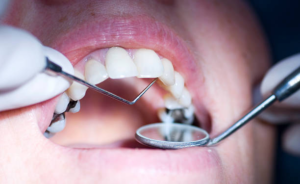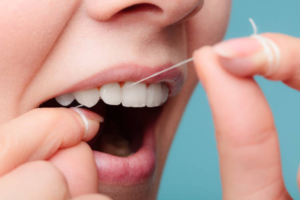Introduction
Root canal treatment might sound daunting. But we are here to simplify things, especially regarding the front teeth – the lateral incisors. They may be small, but they are super important for your smile’s health and appearance.
Dr. M. Phani Babu is a highly experienced dentist in Adyar, known for his expertise in providing comprehensive and personalized dental treatments including lateral incisor root canal treatment.
He founded Dent Eazee, a premier dental clinic in Adyar. Here patients can avail of its exceptional dental care services, from preventive to restorative care.
Dr. Babu aims to make dental procedures easy to understand and manage, ensuring his patients achieve healthier and brighter smiles.
Join us as we make root canals for lateral incisors easy to understand and manage. Let’s get started on this journey to a healthier smile!
Understanding Lateral Incisor Root Canal
 This is a dental procedure that fixes the damage in the lateral incisors. These are the teeth next to the ones in front. They are important for biting and making your smile look awesome.
This is a dental procedure that fixes the damage in the lateral incisors. These are the teeth next to the ones in front. They are important for biting and making your smile look awesome.
Lateral incisors are smaller and can have more curved or narrow root canals. This makes it difficult to access and clean thoroughly.
Their location in the mouth makes them harder to reach and work on. It gets more difficult if there are any anatomical variations in the tooth or surrounding structures.
While most lateral incisors have a single root, some may have two roots (bifurcated) or additional canals, which can complicate the procedure.
All these factors make the lateral incisor root canal more challenging. However, with proper technique and equipment, dentists can effectively treat these teeth and save them from extraction.
Step-by-step procedure for lateral incisor root canal treatment
Your dentist will first numb the area with local anesthesia.
A small opening is made at the top of the tooth (crown) to access the pulp chamber and root canals.
In lateral incisors, the access opening may need to be smaller and more precise due to the tooth’s size.
The dentist cleans the pulp channel and root canal to remove infected or damaged tissue.
The narrow and sometimes curved shape of the root canals in a lateral incisor can make this step more challenging.
The root canal of the lateral incisor is more time-consuming than other tooth root canals.
The canals are disinfected with antimicrobial solutions.
After cleaning and shaping, the dentist fills the cavity with biocompatible material to seal and prevent reinfection.
Root canals are around 95% successful in saving the tooth and eliminating pain and infection.
After your root canal, you must follow your dentist’s instructions like avoiding hard foods for some time, keeping your mouth clean, and going back for check-ups to ensure everything’s okay.
If you are experiencing dental problems, it is important to consult with a dentist who can assess your condition and provide effective treatment.
Do not delay your dental health – Book your consultation with a dentist today for expert care and a healthier smile!
Let’s dive into the factors that can lead to the need for root canal treatment.
Why do you need a root canal treatment?
 Several factors can necessitate root canal treatment, such as:
Several factors can necessitate root canal treatment, such as:
The main culprit is tooth decay, especially if the decay reaches deep into the tooth’s pulp. This may account for about 96% of cases. This decay happens when bacteria produce acids that damage the tooth enamel, leading to cavities.
Additionally, tooth trauma, like getting hit in the mouth, can damage teeth. Root canal treatment of the lateral incisor can be needed if the trauma damages the pulp.
Gum disease causes inflammation and infection that can spread to the tooth’s root. Abscess may form at the root tip due to infections.
Furthermore, cracked teeth from biting on hard objects or teeth grinding can expose the inner layers of the tooth, making it prone to infection and decay.
All these factors underline the importance of timely treatment to prevent further damage and maintain oral health.
Feeling a bit nervous about your upcoming root canal for a lateral incisor? Let’s get you prepped and confident!
Preparing for lateral incisor treatment
Getting ready for a root canal? Here’s what you should know:
- Schedule a consultation with your dentist to discuss the treatment plan. They will check your tooth to see if a root canal is needed.
- Tell your dentist about any health issues or medications you are taking. This helps them plan the treatment.
- Your dentist may give you some instructions before the procedure, like fasting or stopping some medications, like blood thinners.
- Use calming techniques, like deep breaths or listening to music, before the procedure to relax.
- Be prepared for post-treatment care, such as changes in diet and brushing habits.
- Keep track of follow-up visits to ensure everything is going well.
If you are preparing for a root canal treatment, ensure you are ready by booking a consultation with your dentist. Consider a renowned clinic like Dent Eazee, experts in root canal treatment in Adyar.
Experienced dentists can guide you through the process and provide necessary assistance. Visit a trusted dental clinic for your dental issues!
FAQs
Ready to breeze through your recovery? Let’s delve into the recovery & aftercare tips!
Recovery and aftercare

Aftercare is very important for proper and smooth recovery after a root canal treatment. Follow this advice by Dr. Phani Babu:
- Pain Management: Take prescribed pain medications as directed by your dentist.
- Oral Hygiene: Maintain good oral hygiene by brushing and flossing regularly, but avoid the treated area until it heals.
- Diet: Eat soft foods and avoid chewing on the treated side of your mouth until sensitivity decreases.
- Rest: Allow yourself time to rest and recover, avoiding strenuous activities for at least 24 hours post-treatment.
- Follow-Up Appointments: Attend all scheduled follow-up appointments to ensure proper healing and address any concerns.
- Avoid Smoking: Refrain from smoking, as it can impede the healing process.
- Monitor Symptoms: Watch for any signs of complications, such as severe pain, swelling, or fever, and contact your dentist if they occur.
Remember, recovery takes time, so be patient with yourself. If you are unsure about anything, don’t hesitate to reach out to your doctor for help.
Take the next step! Reach out to a trusted dental clinic for top-notch root canal treatment.
Conclusion
Understanding the importance of lateral incisors and the need for root canal treatment can help you take proactive steps. By staying informed, you can make smart choices about your dental well-being. Your smile matters, so if you suspect any issues, don’t hesitate to reach out to your dentist.
Together with dental care professionals, you can keep your smile healthy and radiant for years to come. Enquire now!
FAQs
When is a root canal necessary for the lateral incisor?
This is necessary when the tooth is damaged or infected, causing pain, sensitivity, swelling, or discoloration.
How long does a root canal take on an incisor?
A root canal on an incisor typically takes about 30 to 90 minutes, depending on the complexity of the case. Also, the treatment requires a couple of sessions.
Can I eat normally after the lateral incisor root canal?
Yes, you can gradually return to normal eating habits after a lateral incisor root canal, starting with soft foods and avoiding chewing on the treated side initially. Follow your dentist’s instructions for the best results.

